367. Dockside in Falmouth Foreside at Handy Boat: Gorgeous ocean view at open air bar. Great drinks and many appetizers!http://www.thedocksidegrill.com/
Southern Maine life Fun Things to do NANCY TIMBERLAKE RE/MAX Shoreline The Common at 88 Middle Street Portland, Maine 04101; (207) 553-7314 ntimberlake@homesinmaine.com
Food, Entertainment, and Arts

Saturday, August 30, 2014
Thursday, August 28, 2014
Safe Water and Money
7 Smart Ways to Save Water (and Money!)
- Published: June 25, 2014
- By: Deirdre Sullivan
These water-saving products make every drop count. Some can even trim your electric bill.
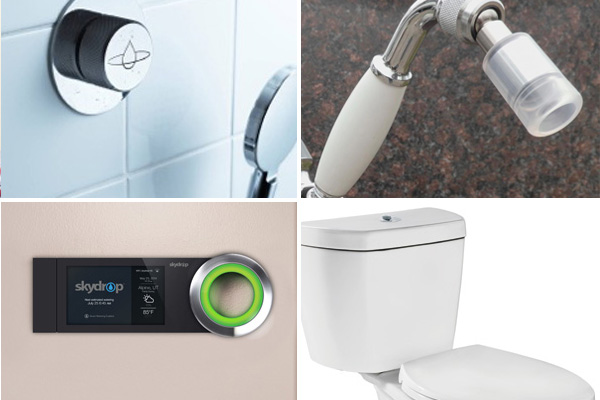 From a dual-flush toilet to a Wi-Fi-enabled sprinkler controller, these products can help reduce your home's water use inside and out. Image: Orbital Systems AB/High Sierra Showerheads/Niagara Conservation/Skydrop
From a dual-flush toilet to a Wi-Fi-enabled sprinkler controller, these products can help reduce your home's water use inside and out. Image: Orbital Systems AB/High Sierra Showerheads/Niagara Conservation/SkydropEven if you live in an area where water is plentiful, drought can still strike thanks to climate change. In some parts of the country, water conservation is the law, and you can get serious fines — or even have your water service terminated — if you use too much H2O.
To help keep your water usage low (and trim your utility bills in the process), we rounded up seven of the latest water-sipping products that make conserving a no-brainer.
1. A Maximum-Performance Toilet
Here’s the deal: Your home’s biggest indoor water hog is the toilet. Approximately 30% of a household’s yearly indoor water use is flushed down the loo.
Toilets that were manufactured before 1992 can use up to 6 gallons per flush (gpf), but a commode that’s earned the WaterSense label uses a mere 1.28 gpf. Installing one could reduce the amount of water used for flushing by up to 60%.
Product pick: The Stealth Dual Flush by Niagara. Dual-flush toilets are high-efficiency commodes that save water by providing a separate flush for solid and liquid wastes. The Stealth uses less than a gallon for solids and a mere half-gallon for liquid waste — almost double the efficiency required by WaterSense. You’ll save nearly 20,000 gallons of H2O and trim yearly water costs by $165.
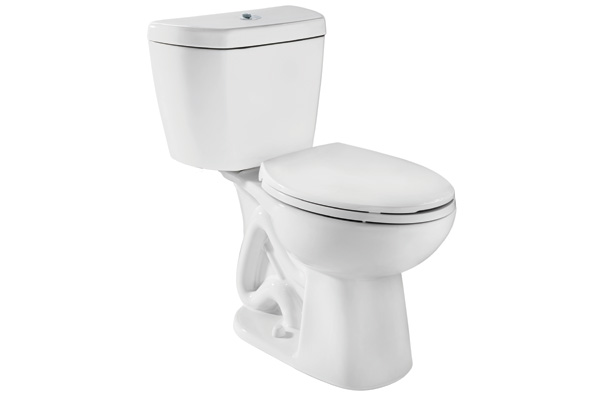
Image: Niagara Conservation
Retail price: $350
Tip: Your toilet is wasting water if its flapper doesn’t close properly. To fix, replace the flapper.
2. A Sprinkler Controller that Thinks for You
Here’s the deal: Up to 50% of our outdoor water use is squandered by overwatering. An irrigation controller helps stop pouring this precious resource down the drain.
The EPA suggests homeowners use an automated, programmable controller set to a watering schedule based on information provided by their local utility. Controllers with Wi-Fi connections go one step further by automatically adjusting watering schedules based on current weather conditions.
Product pick: The Skydrop Sprinkler Controller. Connected to the Internet, the Skydrop creates a custom watering schedule for your lawn based on up-to-date, hyper-local weather data. The manufacturer says homeowners can save up to 75,000 gallons of water per year, based on a 15,000-square-foot yard that’s watered four days per week, 12 months per year.
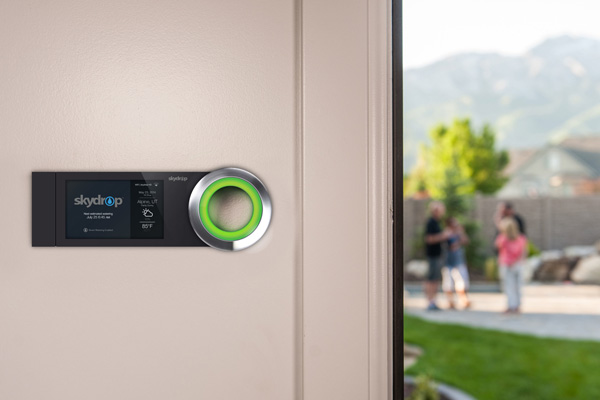
Image: Skydrop
Retail price: $299, but due to high demand there’s a wait list.
Tip: Avoid watering your lawn on windy days when the water blows away.
3. A Shower Head with Real Power
Here’s the deal: We love hot showers so much that they account for 12% of our indoor water use. While most standard shower heads provide 2.5 gallons per minute (gpm), low-flow shower heads that have earned the WaterSense label use 2.0 gpm or less. Making the switch could save your household around 3,000 gallons of water per year while reducing demand on your home’s hot water heater.
However, low-flows have a problem. They provide users with wimpy showers, according to Consumer Reports. They also plug up easily because the little nozzle holes where the water sprays out are up to 40% smaller than standard shower head nozzles.
Product pick: The High Sierra Showerhead is a 1.5 gpm low-flow solution that uses a patented single nozzle to create a powerful shower. Users say it rinses soapy long hair just like a 2.5 gpm shower head.
A shower head that uses 2.0 gpm can save homeowners $70 on water costs and up to 370 kilowatt hours of electricity per year (enough to power a house for 13 days!) The High Sierra raises the ante, claiming to save about 25% more on water and electricity annually.
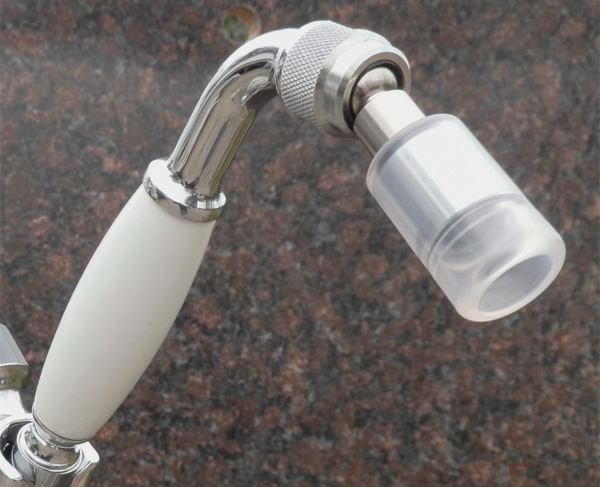
Image: High Sierra Showerheads
Retail price: $35.95
Tip: You can save up to 150 gallons of water each month by shortening your shower by one to two minutes.
This news segment explains why one California inn installed these low-flow shower heads.
4. The Shower of the Future
Here’s the deal: Shower systems that recycle greywater can slash the amount of H2O and even electricity wasted while taking a hot shower.
Product pick: Instead of allowing water to go down the drain, the OrbSys Shower uses a closed-loop, recirculating system to capture and recycle used shower water. The shower’s filtration system purifies the water, making it cleaner than when it was first piped in. Afterwards, the water is pumped back up to the shower head as needed.
Because the capture and cleaning process keeps the heated water from cooling, the manufacturer claims it can save up to 80% of the electricity used to heat a standard shower.

Image: Orbital Systems AB
Retail price: Not yet available for purchase
Tip: A leaky shower head that drips 30 times per minute can waste up to 2.5 gallons of water per day.
5. An Ultra-Efficient Washing Machine
Here’s the deal: Clothes washers can suck up to 15% of a home’s total indoor water use. Since the average household knocks out 300 loads of laundry each year, a non-certified standard machine can consume over 9,000 gallons of water annually.
Product pick: The Kenmore 417.4112 is the top choice on the Energy Star Most Efficient 2014 qualified product list for clothes washers. This front-load washer uses 43% less water and 63% less power than non-certified machines.
That means it’ll reduce your annual water use to about 5,000 gallons per year, while using less electricity. Energy Star says the Kenmore 417.4112 also has the lowest annual ($74 to $79) and lowest lifetime ($814 to $866) operating costs for electric and water.
Retail price: $899
Tip: You can find leaks by monitoring your water bill. Just keep your eyes peeled for spikes in water use.
6. The Washing Machine of the Future
Here’s the deal: Washing one load of dirty clothing can guzzle up to 23 gallons of water. If your machine is more than 10 years old, it can consume up to 40 gallons per load.
Product pick: The Xeros washing machine uses up to 80% less water. How? It employs over 1 million tiny nylon polymer beads to scrub clothes clean. The beads absorb stains off dirty clothing using humidity, lower heating temperatures, and half the amount of detergent used by standard washers. Even better, the beads can be reused hundreds of times.
Retail price: Industrial washers are currently in use; Xeros hopes to release a competitively priced consumer version in two years.
Tip: Using cold water to clean your dark laundry helps retain fabric color while saving water and electricity.
7. A Powerful Outdoor Washer
Here’s the deal: A traditional pressure washer or hose with sprayer uses up to 18 gallons of water per minute. The puddles they leave behind can create urban-runoff that contributes to flooding and water pollution. Also, when done incorrectly, power-washing can cause property damage.
Product pick: The Watermiser Waterbroom is a powerful cleaning machine that uses a combination of water and air to clean pavers, epoxy floors, driveways, patios, and pool decks, using as little as 2 gallons of water per minute. Because the Waterbroom doesn’t contribute to urban-runoff, it’s compliant with all state storm water waste laws and EPA regulations.
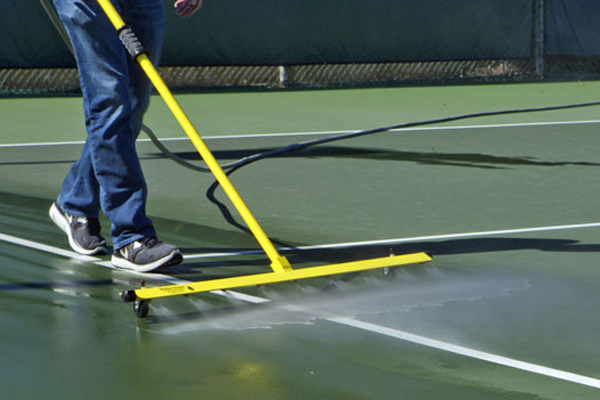
Image: Watermiser Waterbroom
Retail price: Starts at $299
Tip: Fertilizers can increase the amount of water your landscape consumes so use the minimum amount needed.
1. A Maximum-Performance Toilet
Here’s the deal: Your home’s biggest indoor water hog is the toilet. Approximately 30% of a household’s yearly indoor water use is flushed down the loo.
Toilets that were manufactured before 1992 can use up to 6 gallons per flush (gpf), but a commode that’s earned the WaterSense label uses a mere 1.28 gpf. Installing one could reduce the amount of water used for flushing by up to 60%.
Product pick: The Stealth Dual Flush by Niagara. Dual-flush toilets are high-efficiency commodes that save water by providing a separate flush for solid and liquid wastes. The Stealth uses less than a gallon for solids and a mere half-gallon for liquid waste — almost double the efficiency required by WaterSense. You’ll save nearly 20,000 gallons of H2O and trim yearly water costs by $165.

Image: Niagara Conservation
Retail price: $350
Tip: Your toilet is wasting water if its flapper doesn’t close properly. To fix, replace the flapper.
2. A Sprinkler Controller that Thinks for You
Here’s the deal: Up to 50% of our outdoor water use is squandered by overwatering. An irrigation controller helps stop pouring this precious resource down the drain.
The EPA suggests homeowners use an automated, programmable controller set to a watering schedule based on information provided by their local utility. Controllers with Wi-Fi connections go one step further by automatically adjusting watering schedules based on current weather conditions.
Product pick: The Skydrop Sprinkler Controller. Connected to the Internet, the Skydrop creates a custom watering schedule for your lawn based on up-to-date, hyper-local weather data. The manufacturer says homeowners can save up to 75,000 gallons of water per year, based on a 15,000-square-foot yard that’s watered four days per week, 12 months per year.

Image: Skydrop
Retail price: $299, but due to high demand there’s a wait list.
Tip: Avoid watering your lawn on windy days when the water blows away.
3. A Shower Head with Real Power
Here’s the deal: We love hot showers so much that they account for 12% of our indoor water use. While most standard shower heads provide 2.5 gallons per minute (gpm), low-flow shower heads that have earned the WaterSense label use 2.0 gpm or less. Making the switch could save your household around 3,000 gallons of water per year while reducing demand on your home’s hot water heater.
However, low-flows have a problem. They provide users with wimpy showers, according to Consumer Reports. They also plug up easily because the little nozzle holes where the water sprays out are up to 40% smaller than standard shower head nozzles.
Product pick: The High Sierra Showerhead is a 1.5 gpm low-flow solution that uses a patented single nozzle to create a powerful shower. Users say it rinses soapy long hair just like a 2.5 gpm shower head.
A shower head that uses 2.0 gpm can save homeowners $70 on water costs and up to 370 kilowatt hours of electricity per year (enough to power a house for 13 days!) The High Sierra raises the ante, claiming to save about 25% more on water and electricity annually.

Image: High Sierra Showerheads
Retail price: $35.95
Tip: You can save up to 150 gallons of water each month by shortening your shower by one to two minutes.
This news segment explains why one California inn installed these low-flow shower heads.
4. The Shower of the Future
Here’s the deal: Shower systems that recycle greywater can slash the amount of H2O and even electricity wasted while taking a hot shower.
Product pick: Instead of allowing water to go down the drain, the OrbSys Shower uses a closed-loop, recirculating system to capture and recycle used shower water. The shower’s filtration system purifies the water, making it cleaner than when it was first piped in. Afterwards, the water is pumped back up to the shower head as needed.
Because the capture and cleaning process keeps the heated water from cooling, the manufacturer claims it can save up to 80% of the electricity used to heat a standard shower.

Image: Orbital Systems AB
Retail price: Not yet available for purchase
Tip: A leaky shower head that drips 30 times per minute can waste up to 2.5 gallons of water per day.
5. An Ultra-Efficient Washing Machine
Here’s the deal: Clothes washers can suck up to 15% of a home’s total indoor water use. Since the average household knocks out 300 loads of laundry each year, a non-certified standard machine can consume over 9,000 gallons of water annually.
Product pick: The Kenmore 417.4112 is the top choice on the Energy Star Most Efficient 2014 qualified product list for clothes washers. This front-load washer uses 43% less water and 63% less power than non-certified machines.
That means it’ll reduce your annual water use to about 5,000 gallons per year, while using less electricity. Energy Star says the Kenmore 417.4112 also has the lowest annual ($74 to $79) and lowest lifetime ($814 to $866) operating costs for electric and water.
Retail price: $899
Tip: You can find leaks by monitoring your water bill. Just keep your eyes peeled for spikes in water use.
6. The Washing Machine of the Future
Here’s the deal: Washing one load of dirty clothing can guzzle up to 23 gallons of water. If your machine is more than 10 years old, it can consume up to 40 gallons per load.
Product pick: The Xeros washing machine uses up to 80% less water. How? It employs over 1 million tiny nylon polymer beads to scrub clothes clean. The beads absorb stains off dirty clothing using humidity, lower heating temperatures, and half the amount of detergent used by standard washers. Even better, the beads can be reused hundreds of times.
Retail price: Industrial washers are currently in use; Xeros hopes to release a competitively priced consumer version in two years.
Tip: Using cold water to clean your dark laundry helps retain fabric color while saving water and electricity.
7. A Powerful Outdoor Washer
Here’s the deal: A traditional pressure washer or hose with sprayer uses up to 18 gallons of water per minute. The puddles they leave behind can create urban-runoff that contributes to flooding and water pollution. Also, when done incorrectly, power-washing can cause property damage.
Product pick: The Watermiser Waterbroom is a powerful cleaning machine that uses a combination of water and air to clean pavers, epoxy floors, driveways, patios, and pool decks, using as little as 2 gallons of water per minute. Because the Waterbroom doesn’t contribute to urban-runoff, it’s compliant with all state storm water waste laws and EPA regulations.

Image: Watermiser Waterbroom
Retail price: Starts at $299
Tip: Fertilizers can increase the amount of water your landscape consumes so use the minimum amount needed.
 Deirdre Sullivan is an NYC-based writer who’s obsessed with maximizing every inch of her urban dwelling. She’s a former fashionista who has worked for Lucky Magazine and InStyle. She recently traded her high heels and Fashion Week pass for a drill and bandsaw. Follow Deirdre on Google+.
Deirdre Sullivan is an NYC-based writer who’s obsessed with maximizing every inch of her urban dwelling. She’s a former fashionista who has worked for Lucky Magazine and InStyle. She recently traded her high heels and Fashion Week pass for a drill and bandsaw. Follow Deirdre on Google+.Read more: http://www.houselogic.com/home-advice/saving-water/7-smart-ways-save-water-and-money/#ixzz3Bhanqxgz
Follow us: @HouseLogic on Twitter | HouseLogic on Facebook
Tuesday, August 26, 2014
Value of Home Improvements
Appraiser Group Offers “Feasibility Study” to Test Value of Home Improvements
- Published: June 11, 2013
Appraisers think homeowners should get opinion on future value before major remodeling.
The appraisal industry is pushing a new product aimed at homeowners considering a major home improvement: a feasibility study analyzing what your home will be worth before and after the project.
The Appraisal Institute, a trade association for real estate appraisers, says a feasibility study weighs the cost of rehab projects against an estimate of the property’s value before and after the improvement.
Appraisal Institute President Richard Borges II claims the study would help homeowners avoid spending money they won’t recoup at resale, particularly if the improvements don’t jibe with standards for the community.
Of course, remodeling decisions involve more than dollars; you should also consider your enjoyment of your home.
In addition, if you don’t want to spend several hundred dollars on a feasibility study — appraisals typically cost between $200 and $500 — consult your REALTOR®, who can advise you about what the project might add to your home. A REALTOR® will be familiar with the interiors and exteriors of homes in your neighborhood as well as recent sales prices.
According to Remodeling magazine’s most recent Cost vs. Value report, the projects with the highest expected return on investment include:
When you’re calculating cost and value, think about how long you plan to stay in your home, Borges added. The longer you do, the greater the opportunity for a return on investment, he said.
Some green and energy-efficient renovations, such as adding Energy Star appliances and extra insulation, can pay you back relatively quickly via lowered utility bills, or by enticing homebuyers to choose your home over a less-efficient home.
In the feasibility study, your appraiser can assess local supply and demand for green and energy-efficient properties and features, Borges said.
The Appraisal Institute, a trade association for real estate appraisers, says a feasibility study weighs the cost of rehab projects against an estimate of the property’s value before and after the improvement.
Appraisal Institute President Richard Borges II claims the study would help homeowners avoid spending money they won’t recoup at resale, particularly if the improvements don’t jibe with standards for the community.
Of course, remodeling decisions involve more than dollars; you should also consider your enjoyment of your home.
In addition, if you don’t want to spend several hundred dollars on a feasibility study — appraisals typically cost between $200 and $500 — consult your REALTOR®, who can advise you about what the project might add to your home. A REALTOR® will be familiar with the interiors and exteriors of homes in your neighborhood as well as recent sales prices.
According to Remodeling magazine’s most recent Cost vs. Value report, the projects with the highest expected return on investment include:
When you’re calculating cost and value, think about how long you plan to stay in your home, Borges added. The longer you do, the greater the opportunity for a return on investment, he said.
Some green and energy-efficient renovations, such as adding Energy Star appliances and extra insulation, can pay you back relatively quickly via lowered utility bills, or by enticing homebuyers to choose your home over a less-efficient home.
In the feasibility study, your appraiser can assess local supply and demand for green and energy-efficient properties and features, Borges said.
Read more: http://www.houselogic.com/news/home-improvement/appraiser-group-offers-feasibility-study-test-value-home-improvements/#ixzz3BY1d4ZDW
101Things I Love about Portland Maine




366. The Way Way Store for old-fashioned fun treats--penny candy, ice cream, antiques and fresh veggies.
https://www.facebook.com/waywaystore
Wednesday, August 20, 2014
Competing Offers--No Fear!
Competition fears.I recently had a buyer text me the address of a home they saw for sale, listed within their price range. A moment later I received another text from the same buyer: a note that they know they’ll never be able to afford it because of all the traffic they saw at the open house and the multiple offers they assumed would result. It’s great for buyers to have a realistic understanding of local market dynamics like whether it’s a buyer’s or a seller’s market, how long homes tend to stay on the market, whether they should expect to compete with other offers and how much above or below asking homes usually sell for.
But in a hot market this can result in buyers disqualifying themselves, mentally, from homes on which they should be making offers. Listing agents can help keep competition fears from running good buyers off by keeping buyer’s brokers who show the place up-to-date on plans for accepting offers and what the competition level truly is (assuming the latter is fine by your sellers and any applicable Association rules). Buyer’s brokers can keep competition fears grounded in reality by checking in with the listing agent about the number of offers expected or received and non-price terms of particular interest to the sellers.
From Article by Tara-Nicholle Nelson on TruliaProBlog
Sunday, August 17, 2014
Wednesday, August 13, 2014
Moving
Make Moving Easier
Whether you're planning a move across town or across the country, making the move hassle-free is what it is all about. Besides the traditional garage sale and packing of boxes, there are a few details you won't want to forget before you begin loading the truck:
Plan Ahead
Experts recommend scheduling moves at least one month in advance, especially during the peak-moving season between May and September. Some estimates indicate 80 percent of all moving and storage business is done when schools are out. That's when employees are most likely to be transferred.
Ask Questions
Take the time to get as much information as possible from moving companies before selecting one. Check on truck size and availability. Ask about moving supplies, such as boxes, dollies and furniture pads. Find out about protection plans for your possessions. Ask about lost or damaged property claim procedures. Determine price differences in packing the truck yourself or having it professionally packed. Get estimates.
Save Your Receipts
Many of your moving expenses are tax deductible, so hang onto your receipts. Consult with your tax advisor to find out what is deductible, or call the Internal Revenue Service and request Publication 521: "Tax Information On Moving Expenses" to find out which moving expenses are deductible.
Collect Documents
If you're moving out of the area, you'll need to gather your family's personal records. Remember to get your medical and dental records, school transcripts, legal documents, titles, bank records, tax returns, stocks and bonds certificates, birth certificates, passports and insurance documents. Be sure to empty your safe deposit box.
Fantastic Desserts ar Krista's in Cornish
Beautifully presented, incredibly decadent desserts. The hardest part will be to select one from the dessert tray--they are all amazing.
Grammy's chocolate cake and the huge ice cream sandwich of the day were fab!!
http://kristasrestaurant.com/
Saturday, August 9, 2014
101 Things I Love about Portland Maine
Wednesday, August 6, 2014
How to Prevent Weeds from Ever Sprouting
How to Prevent Weeds from Ever Sprouting
When it comes to weeds in your garden, an hour of prevention is better than a season of yanking.
Unlike seeds and plants you buy from catalogs and nurseries, indigenous common weeds are naturally suited to the sun, soil, and water conditions of your garden. That’s why it’s so hard to get rid of weeds after they’ve taken root.
But if you prevent weed seeds from germinating, your garden will be weed-free. Here are some surefire ways to keep weeds from growing in the first place.
Shhh! Don’t Disturb the Soil
Weed seeds “sleep” in your soil all the time, just waiting for sunshine to enable them to germinate. Left underground, many weed seeds remain dormant for years. So the less you disturb the soil, the more likely weed seeds will remain asleep.
Avoid high-powered tillers, and go easy on the hand cultivating. Sow your flower and vegetable seeds above the ground in mounds of compost, shredded leaves, or even in bags of topsoil. Better yet, plant seedlings and starts.
Smother Weed Seeds
Another way to keep seeds asleep is to cover your soil with sun-blocking organic or synthetic mulches.
Organic mulches — hardwood mulch, newspaper, cardboard, straw — degrade in a few months and improve soil structure and add nutrients. Synthetic mulches — landscaping paper, plastic — can last several seasons, but won’t help rebuild soil when they eventually degrade.
Heed these mulching tips:
Wage a Chemical Attack
Pre-emergent herbicides prevent weed seeds from germinating, but don’t kill existing plants and grasses.
The exact timing for applying a pre-emergent herbicide is hard to pinpoint because you must spread the herbicide before seeds germinate, which happens underground at different times.
Conventional gardening wisdom says spread pre-emergent herbicides when the daffodils pop or the forsythia wilts. But advance planning is the best way to determine when to spread. Log the date when you see the first weeds in your garden, then subtract three weeks to arrive at the date you should spread the pre-emergent herbicide next spring.
Grow Up Close and Personal
The closer together you plant your flowers and vegetables, the less space weed seeds will have to grow.
If you double-dig — loosen (don’t pulverize) soil at least 2 feet down — you can plant cheek-by-jowl, because plant roots can grow down, not out, to find water and nourishment. If you plant intensively in a diamond-shaped pattern — rather than rows — you’ll avoid barren spots where weeds will grow.
To keep weeds out of lawns, make sure your grass is lush and healthy so weeds have no room to grow. Reseed bald patches; fertilize if a soil test determines nutrient deficiencies; aerate in the fall.
Test your weed knowledge with this slideshow of common weeds.
Need to Kill Weeds?
Shhh! Don’t Disturb the Soil
Weed seeds “sleep” in your soil all the time, just waiting for sunshine to enable them to germinate. Left underground, many weed seeds remain dormant for years. So the less you disturb the soil, the more likely weed seeds will remain asleep.
Avoid high-powered tillers, and go easy on the hand cultivating. Sow your flower and vegetable seeds above the ground in mounds of compost, shredded leaves, or even in bags of topsoil. Better yet, plant seedlings and starts.
Smother Weed Seeds
Another way to keep seeds asleep is to cover your soil with sun-blocking organic or synthetic mulches.
Organic mulches — hardwood mulch, newspaper, cardboard, straw — degrade in a few months and improve soil structure and add nutrients. Synthetic mulches — landscaping paper, plastic — can last several seasons, but won’t help rebuild soil when they eventually degrade.
Heed these mulching tips:
- Wet the ground before you lay down layers of paper, which will prevent the paper from blowing away while you work.
- Scout yard sales for old carpet and wallpaper, efficient sun blocks that prevent weeds.
- Spread mulch 2 to 4 inches deep to suppress weeds and retain moisture.
- Always pick straw, not hay, to prevent weeds. Hay usually contains hayseeds, which will sprout where you’re trying to keep weeds out.
Wage a Chemical Attack
Pre-emergent herbicides prevent weed seeds from germinating, but don’t kill existing plants and grasses.
The exact timing for applying a pre-emergent herbicide is hard to pinpoint because you must spread the herbicide before seeds germinate, which happens underground at different times.
Conventional gardening wisdom says spread pre-emergent herbicides when the daffodils pop or the forsythia wilts. But advance planning is the best way to determine when to spread. Log the date when you see the first weeds in your garden, then subtract three weeks to arrive at the date you should spread the pre-emergent herbicide next spring.
Grow Up Close and Personal
The closer together you plant your flowers and vegetables, the less space weed seeds will have to grow.
If you double-dig — loosen (don’t pulverize) soil at least 2 feet down — you can plant cheek-by-jowl, because plant roots can grow down, not out, to find water and nourishment. If you plant intensively in a diamond-shaped pattern — rather than rows — you’ll avoid barren spots where weeds will grow.
To keep weeds out of lawns, make sure your grass is lush and healthy so weeds have no room to grow. Reseed bald patches; fertilize if a soil test determines nutrient deficiencies; aerate in the fall.
Test your weed knowledge with this slideshow of common weeds.
Need to Kill Weeds?
 Lisa Kaplan Gordon is an avid gardener, a member of the Fairfax County Master Gardeners Association, and a builder of luxury homes in McLean, Va. She’s been a Homes editor for Gannett News Service and has reviewed home improvement products for AOL. Follow Lisa on Google+.
Lisa Kaplan Gordon is an avid gardener, a member of the Fairfax County Master Gardeners Association, and a builder of luxury homes in McLean, Va. She’s been a Homes editor for Gannett News Service and has reviewed home improvement products for AOL. Follow Lisa on Google+.Read more: http://www.houselogic.com/home-advice/gardens/how-to-prevent-weeds/#ixzz39cx3buYx
Follow us: @HouseLogic on Twitter | HouseLogic on Facebook
Tuesday, August 5, 2014
Subscribe to:
Posts (Atom)







































